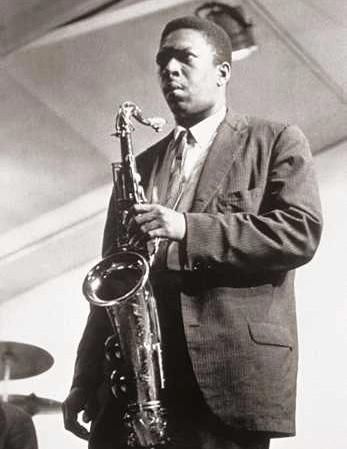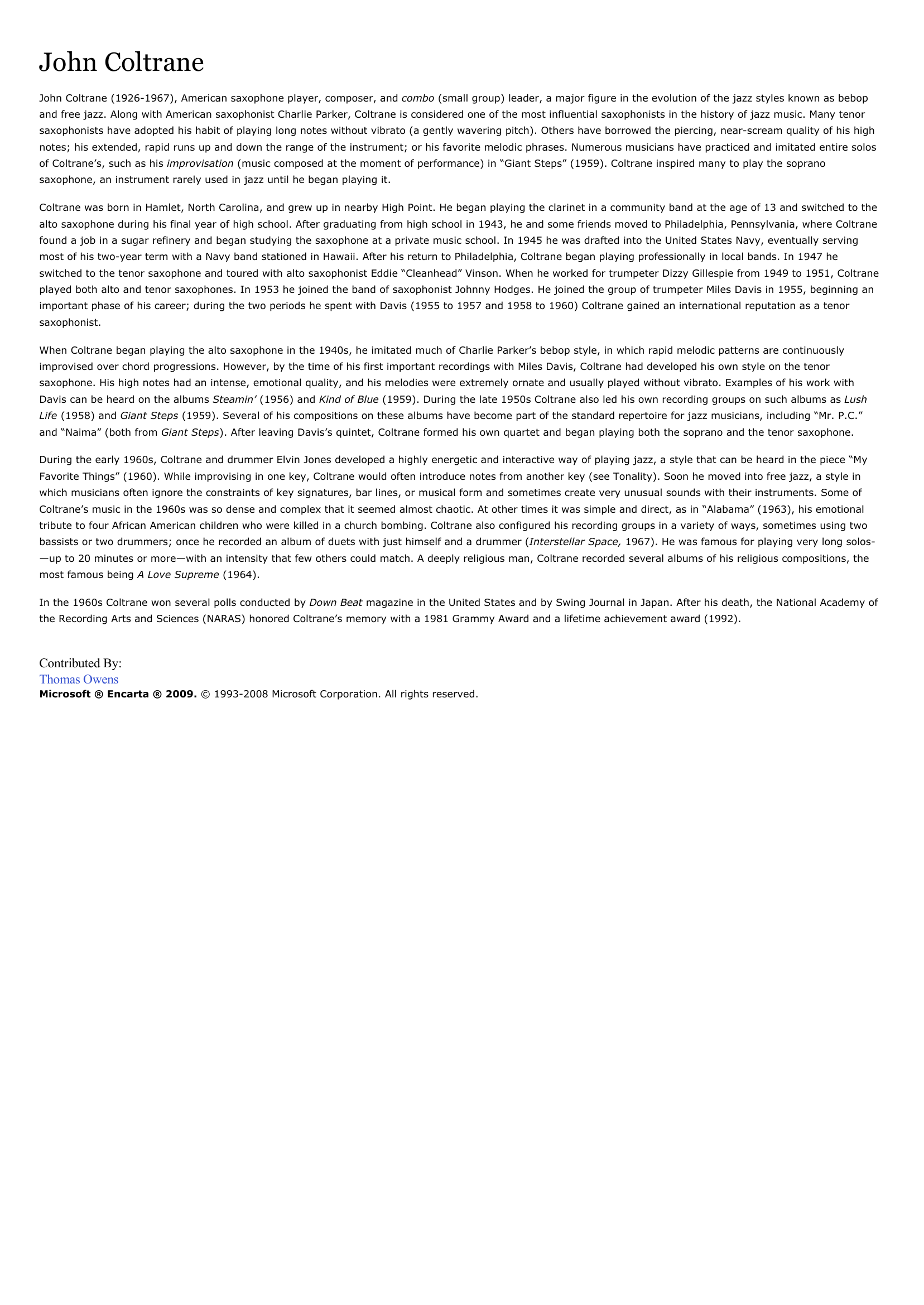Coltrane John
Publié le 07/04/2019
Extrait du document

Coltrane John Saxophoniste de jazz américain
* 23.9.1926, Hamlet, Caroline du Nord
+ 17.7.1967, New York
Il se fait d'abord connaître dans les groupes de Dizzy Gillespie et de Miles Davis, où il interprète son solo \"Round about midnight\". A partir de 1960, il dirige son propre quartet. Avec une parfaite maîtrise instrumentale, il imagine une technique de jeu avec chevauchement rapide d'une note par la suivante ; par la suite, ses improvisations se fondent davantage sur les gammes que sur les accords. Son album \"Ascension\" (1965) est à l'origine de la naissance du free-jazz. Virtuose d'exception, il exerce sur le jazz une influence déterminante qui survit à sa disparition prématurée.

«
Powered by TCPDF (www.tcpdf.org)John Coltrane
John Coltrane (1926-1967), American saxophone player, composer, and combo (small group) leader, a major figure in the evolution of the jazz styles known as bebop and free jazz.
Along with American saxophonist Charlie Parker, Coltrane is considered one of the most influential saxophonists in the history of jazz music.
Many tenorsaxophonists have adopted his habit of playing long notes without vibrato (a gently wavering pitch).
Others have borrowed the piercing, near-scream quality of his highnotes; his extended, rapid runs up and down the range of the instrument; or his favorite melodic phrases.
Numerous musicians have practiced and imitated entire solosof Coltrane’s, such as his improvisation (music composed at the moment of performance) in “Giant Steps” (1959).
Coltrane inspired many to play the soprano saxophone, an instrument rarely used in jazz until he began playing it.
Coltrane was born in Hamlet, North Carolina, and grew up in nearby High Point.
He began playing the clarinet in a community band at the age of 13 and switched to thealto saxophone during his final year of high school.
After graduating from high school in 1943, he and some friends moved to Philadelphia, Pennsylvania, where Coltranefound a job in a sugar refinery and began studying the saxophone at a private music school.
In 1945 he was drafted into the United States Navy, eventually servingmost of his two-year term with a Navy band stationed in Hawaii.
After his return to Philadelphia, Coltrane began playing professionally in local bands.
In 1947 heswitched to the tenor saxophone and toured with alto saxophonist Eddie “Cleanhead” Vinson.
When he worked for trumpeter Dizzy Gillespie from 1949 to 1951, Coltraneplayed both alto and tenor saxophones.
In 1953 he joined the band of saxophonist Johnny Hodges.
He joined the group of trumpeter Miles Davis in 1955, beginning animportant phase of his career; during the two periods he spent with Davis (1955 to 1957 and 1958 to 1960) Coltrane gained an international reputation as a tenorsaxophonist.
When Coltrane began playing the alto saxophone in the 1940s, he imitated much of Charlie Parker’s bebop style, in which rapid melodic patterns are continuouslyimprovised over chord progressions.
However, by the time of his first important recordings with Miles Davis, Coltrane had developed his own style on the tenorsaxophone.
His high notes had an intense, emotional quality, and his melodies were extremely ornate and usually played without vibrato.
Examples of his work withDavis can be heard on the albums Steamin’ (1956) and Kind of Blue (1959).
During the late 1950s Coltrane also led his own recording groups on such albums as Lush Life (1958) and Giant Steps (1959).
Several of his compositions on these albums have become part of the standard repertoire for jazz musicians, including “Mr.
P.C.” and “Naima” (both from Giant Steps ).
After leaving Davis’s quintet, Coltrane formed his own quartet and began playing both the soprano and the tenor saxophone.
During the early 1960s, Coltrane and drummer Elvin Jones developed a highly energetic and interactive way of playing jazz, a style that can be heard in the piece “MyFavorite Things” (1960).
While improvising in one key, Coltrane would often introduce notes from another key (see Tonality).
Soon he moved into free jazz, a style inwhich musicians often ignore the constraints of key signatures, bar lines, or musical form and sometimes create very unusual sounds with their instruments.
Some ofColtrane’s music in the 1960s was so dense and complex that it seemed almost chaotic.
At other times it was simple and direct, as in “Alabama” (1963), his emotionaltribute to four African American children who were killed in a church bombing.
Coltrane also configured his recording groups in a variety of ways, sometimes using twobassists or two drummers; once he recorded an album of duets with just himself and a drummer ( Interstellar Space, 1967).
He was famous for playing very long solos- —up to 20 minutes or more—with an intensity that few others could match.
A deeply religious man, Coltrane recorded several albums of his religious compositions, themost famous being A Love Supreme (1964).
In the 1960s Coltrane won several polls conducted by Down Beat magazine in the United States and by Swing Journal in Japan.
After his death, the National Academy of the Recording Arts and Sciences (NARAS) honored Coltrane’s memory with a 1981 Grammy Award and a lifetime achievement award (1992).
Contributed By:Thomas OwensMicrosoft ® Encarta ® 2009. © 1993-2008 Microsoft Corporation.
All rights reserved..
»
↓↓↓ APERÇU DU DOCUMENT ↓↓↓
Liens utiles
- John Coltrane - Musik.
- Coltrane William John , 1926-1967, né à Hamlet (Caroline du Nord), saxophoniste américain.
- John Coltrane John Coltrane (1926-1967), American saxophone player, composer, and combo (small group) leader, a major figure in the evolution of the jazz styles known as bebop and free jazz.
- John Coltrane.
- John Locke et les lois - extrait du Second traité du gouvernement civil

































